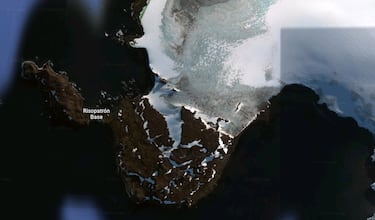Green blooms in Antarctica: this is how vegetation has grown at the South Pole in the last 40 years
Satellite images show that some areas in the north of Antarctica the once frozen continent is beginning to turn green as the planet continues to warm.

Although it may seem like good news, the fact that green is growing in Antarctica is anything but. Research by the English universities of Exeter and Hertfordshire and the British Antarctic Survey has confirmed that vegetation has increased tenfold on this continent in the last four decades.
Scientists have used satellite images to analyse vegetation levels on the Antarctic Peninsula over the years. This place is one of the closest to South America and, therefore, the northernmost place on the entire frozen continent.
Green blooms in Antarctic
In 1986, Antarctic vegetation covered a little more than one third square mile at the time. However, according to the study, in 2021, this vegetation already covered just over 5 square miles, thanks to the significant increase in temperatures on the southern continent.
According to the World Climate Organization, the Antarctic Peninsula, where the British universities' study was carried out, is among the fastest-warming regions on the planet, with almost 3 °C warming in the past 50 years.

Although the rest of the continent remains covered in snow and ice, it is quite worrying that the vegetation cover has increased so much in just four decades. Scientists also point out that the greatest increase has occurred in the last 5 years, which reflects that climate change is only getting worse and we are nowhere near beginning to reverse the consequences.
“Our findings confirm that the influence of anthropogenic climate change has no limits in its scope,” one of the researchers told CNN. “Even on the Antarctic Peninsula, the landscape is changing, and these effects are visible from space.”
Extreme warming
The study offers some very worrying data: during the summer of 2024, several points in Antarctica experienced temperatures 10 degrees above normal for the time of year. And in March 2022, that figure reached 21 degrees, becoming the most extreme thermal deviation ever recorded.
Related stories
Anthropogenic global warming is a reality, say researchers, and it is absolutely necessary to reduce carbon dioxide emissions into the atmosphere to prevent this vegetation from continuing to spread across Antarctica.
The problem is even more serious than we think, since the smaller the surface area covered by snow and ice, the more heat will accumulate on the Earth’s surface. Snow reflects solar radiation back into space, while a surface area covered by vegetation absorbs more heat and contributes to warm the ecosystem.


Complete your personal details to comment